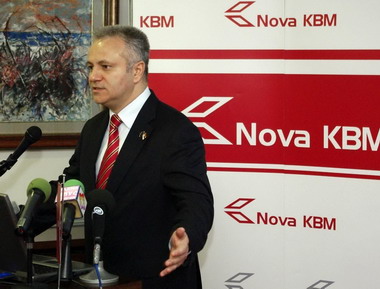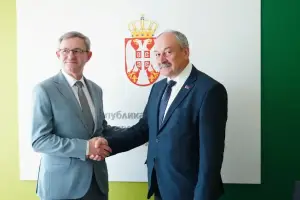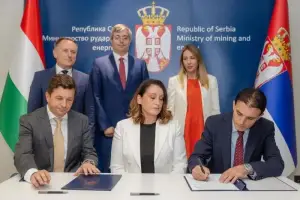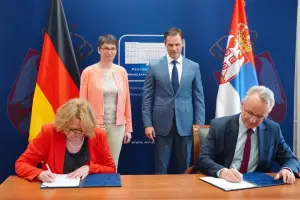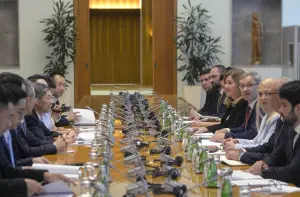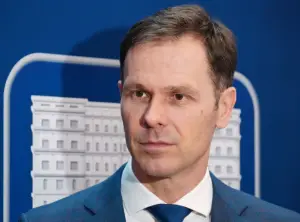Q:
A:
Banking sector in Serbia absorbs blow from crisis
Belgrade,
28 May 2010
Deputy Prime Minister and Minister of Economy and Regional Development Mladjan Dinkic stated today that the state will continue with its floating exchange rate policy and measures for stimulating the economy.
Speaking at a presentation by the Nova Kreditna Banka Maribor (NKBM), Dinkic emphasised that Serbia’s foreign currency reserves stand at €11 billion, which together with the agreement reached with the IMF, will help stabilise the dinar.
It will be recalled that Serbia’s exports during the first quarter of 2010 grew by 15%, compared to the same period in 2009. This confirms that the floating exchange rate policy is producing results, stated Dinkic.
The projected GDP growth rate for 2010 is 1.5%, however it is expected to stand at 2% at the end of the year, he added.
The current inflation rate of 4% is low given the circumstances. The budget deficit stands at 4.8% but the public debt is low, at 32% of GDP. This is much lower than the European average of 72%, observed Dinkic.
The banking sector in Serbia played a key role in softening the blow from the crisis, he stressed, adding that the government did not give a single euro for the recapitalisation of the banking sector, introducing subsidised interest rates instead in order to stimulate and support the economy.
Dinkic talked about events from 2008, when people withdrew €1 billion from banks in just one month and said that measures taken by the Serbian government resolved the situation, as now public savings are up by €500 million compared to before the crisis.
Our policy is to support the electronics and car industries and the information technologies sector. Incentives are being offered to investors per new employee, stressed Dinkic.
Serbia has an advantage because it has free trade agreements with the EU, Russia, Kazakhstan, Belarus and CEFTA signatory countries, a market of one billion consumers, Dinkic remarked.
Our state strategy is to become a market in which goods for exports will be produced and thus we will change the structure of our economy, Dinkic explained.
He outlined that Serbia has commenced works on the completion of Corridor 10 through Vojvodina. The money obtained from the sale of state shares in Telekom Srbija will be used for the construction of the motorway from Belgrade to Cacak, as well as the link route that will connect this motorway with Corridor 10 and regional roads in eastern Serbia.
The Minister highlighted that there are 500 Slovenian companies working in Serbia, which employ a large number of workers and which have invested around $750 million in Serbia.
CEO of the Management Board of NKBM Matjaz Kovacic said that with the acquisition of Kredi bank, this Slovenian group will expand its presence in Serbia.
We have prepared a plan for the restructuring of Kredi bank over the next three years, Kovacic declared and pointed out that KBM is now 25 times more productive than Kredi bank.
The Nova KBM Group has 14 companies, including banks, insurance companies, leasing and real estate companies, with 500,000 clients in Slovenia and 100,000 share holders, Kovacic explained.
This company employs 2,800 people and its volume of business stands at €6 billion. This year for the first time, due to the economic crisis, the Group will not distribute dividends.
This money will be used for investment, Kovacic pointed out and added that the Group’s strategic goal is to secure 20% of its profits through business activity in markets outside Slovenia.
It will be recalled that Serbia’s exports during the first quarter of 2010 grew by 15%, compared to the same period in 2009. This confirms that the floating exchange rate policy is producing results, stated Dinkic.
The projected GDP growth rate for 2010 is 1.5%, however it is expected to stand at 2% at the end of the year, he added.
The current inflation rate of 4% is low given the circumstances. The budget deficit stands at 4.8% but the public debt is low, at 32% of GDP. This is much lower than the European average of 72%, observed Dinkic.
The banking sector in Serbia played a key role in softening the blow from the crisis, he stressed, adding that the government did not give a single euro for the recapitalisation of the banking sector, introducing subsidised interest rates instead in order to stimulate and support the economy.
Dinkic talked about events from 2008, when people withdrew €1 billion from banks in just one month and said that measures taken by the Serbian government resolved the situation, as now public savings are up by €500 million compared to before the crisis.
Our policy is to support the electronics and car industries and the information technologies sector. Incentives are being offered to investors per new employee, stressed Dinkic.
Serbia has an advantage because it has free trade agreements with the EU, Russia, Kazakhstan, Belarus and CEFTA signatory countries, a market of one billion consumers, Dinkic remarked.
Our state strategy is to become a market in which goods for exports will be produced and thus we will change the structure of our economy, Dinkic explained.
He outlined that Serbia has commenced works on the completion of Corridor 10 through Vojvodina. The money obtained from the sale of state shares in Telekom Srbija will be used for the construction of the motorway from Belgrade to Cacak, as well as the link route that will connect this motorway with Corridor 10 and regional roads in eastern Serbia.
The Minister highlighted that there are 500 Slovenian companies working in Serbia, which employ a large number of workers and which have invested around $750 million in Serbia.
CEO of the Management Board of NKBM Matjaz Kovacic said that with the acquisition of Kredi bank, this Slovenian group will expand its presence in Serbia.
We have prepared a plan for the restructuring of Kredi bank over the next three years, Kovacic declared and pointed out that KBM is now 25 times more productive than Kredi bank.
The Nova KBM Group has 14 companies, including banks, insurance companies, leasing and real estate companies, with 500,000 clients in Slovenia and 100,000 share holders, Kovacic explained.
This company employs 2,800 people and its volume of business stands at €6 billion. This year for the first time, due to the economic crisis, the Group will not distribute dividends.
This money will be used for investment, Kovacic pointed out and added that the Group’s strategic goal is to secure 20% of its profits through business activity in markets outside Slovenia.

